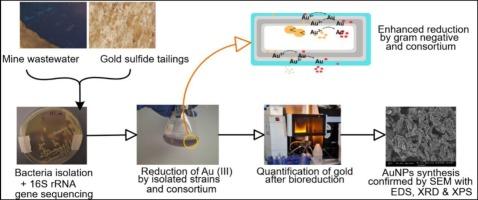从金矿废水中分离的菌株和联合体生物还原金的性能评价(III)
IF 5
2区 工程技术
Q1 ENGINEERING, CHEMICAL
引用次数: 0
摘要
生物还原Au (III)为Au(0)提供了一种可持续和环保的替代传统黄金回收方法,减少了与化学处理相关的环境影响。研究了从金尾矿和矿山废水中分离的原生菌株和微生物群的生物还原能力。在pH为7和35±2°C,初始Au (III)浓度为3和6 ppm的条件下,进行了24 h的好氧批量实验,比较了单个菌株和混合财团的还原效率。革兰氏阴性菌(嗜麦窄营养单胞菌、肺炎克雷伯菌、bereziniae不动杆菌)的还原效率为98.33 - 99.8%,优于革兰氏阳性蜡样芽孢杆菌(92.9%),这可能是由于细胞壁结构的差异,革兰氏阴性菌利用外膜蛋白和高效的细胞外电子转移机制,而蜡样芽孢杆菌依靠其更厚的肽聚糖层进行生物吸附。结果表明,4个菌株的联合效率达到94.5%,反映了资源分配和代谢物循环的协同作用。扫描电子显微镜(SEM)、能量色散X射线能谱(EDS)、X射线衍射(XRD)和X射线光电子能谱(XPS)证实了Au(0)纳米颗粒的形成,尽管初始浓度较低,但该联盟中的结晶金含量为8.5%。这些发现突出了原生细菌从采矿废水和尾矿中高效生物回收黄金的潜力,展示了一种可行的生物湿法冶金工艺,将废物处理与贵金属提取相结合。该技术通过减少化学品消耗、降低能源需求和同时进行环境修复,为采矿作业提供了显著优势,支持该行业向可持续开采实践和矿物加工作业中的循环资源利用过渡。本文章由计算机程序翻译,如有差异,请以英文原文为准。

Performance evaluation of gold (III) bio-reduction by bacterial strains and a consortium isolated from gold mine effluent
The bioreduction of Au (III) to Au (0) offers a sustainable and eco-friendly alternative to conventional gold recovery methods, reducing environmental impacts associated with chemical processing. This study investigated the bioreduction capabilities of indigenous bacterial strains and a microbial consortium isolated from gold tailings and mine wastewater. Aerobic batch experiments were conducted at pH 7 and 35 ± 2°C over 24 h, with initial Au (III) concentrations of 3 and 6 ppm, to compare the reduction efficiencies of individual strains and a mixed consortium. Gram-negative bacteria (Stenotrophomonas maltophilia, Klebsiella pneumoniae, Acinetobacter bereziniae) achieved superior reduction efficiencies of 98.33–99.8 %, outperforming the Gram-positive Bacillus cereus (92.9 %), likely due to differences in cell wall structure, with Gram-negative strains leveraging outer membrane proteins and efficient extracellular electron transfer mechanisms, while B. cereus relies on biosorption via its thicker peptidoglycan layer. The consortium, combining all four strains, reached 94.5 % efficiency, reflecting synergistic interactions through resource partitioning and metabolite recycling. Scanning electron microscope (SEM), Energy-dispersive X-ray spectroscopy (EDS), X- ray diffraction (XRD) and X-ray photoelectron spectroscopy (XPS) confirmed the formation of Au (0) nanoparticles, with an 8.5 % crystalline gold content in the consortium despite low starting concentrations. These findings highlight the potential of indigenous bacteria for efficient gold bio- recovery from mining effluents and tailings, demonstrating a viable bio- hydrometallurgical process that integrates waste treatment with precious metal extraction. The technology offers significant advantages for mining operations through reduced chemical consumption, lower energy requirements, and simultaneous environmental remediation, supporting the industry’s transition toward sustainable extraction practices and circular resource utilization in mineral processing operations.
求助全文
通过发布文献求助,成功后即可免费获取论文全文。
去求助
来源期刊

Minerals Engineering
工程技术-工程:化工
CiteScore
8.70
自引率
18.80%
发文量
519
审稿时长
81 days
期刊介绍:
The purpose of the journal is to provide for the rapid publication of topical papers featuring the latest developments in the allied fields of mineral processing and extractive metallurgy. Its wide ranging coverage of research and practical (operating) topics includes physical separation methods, such as comminution, flotation concentration and dewatering, chemical methods such as bio-, hydro-, and electro-metallurgy, analytical techniques, process control, simulation and instrumentation, and mineralogical aspects of processing. Environmental issues, particularly those pertaining to sustainable development, will also be strongly covered.
 求助内容:
求助内容: 应助结果提醒方式:
应助结果提醒方式:


